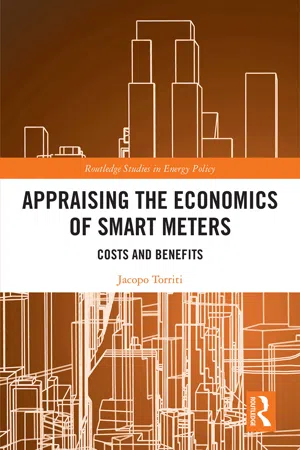
- 172 pages
- English
- ePUB (mobile friendly)
- Available on iOS & Android
About This Book
This book focuses on the economics of smart meters and is one of the first to present comprehensive evidence on the impacts, cost-benefits and risks associated with smart metering.
Throughout this volume, Jacopo Torriti integrates his findings from institutional cost-benefit analyses and smart metering trials in a range of European countries with key economic and social concepts and policy insights derived from almost ten years of research in this area. He explores the extent to which the benefits of smart meters outweigh the cost, and poses key questions including: which energy savings can be expected from the roll out of smart meters in households? Is Cost-Benefit Analysis an appropriate economic tool for assessing the impacts of smart metering rollouts? Can smart meters play a significant role in research on people's activities and the timing of energy demand? Torriti concludes by providing a much-needed survey of recent changes and expected future developments in this growing field.
This book will be of great interest to students and scholars of energy policy and demand and smart metering infrastructure.
Frequently asked questions
1 Are smart meters worth the cost?
Waiting for meter data
- – What is it papà?
- – It’s a smart meter. Well, an in-home display.
- – What does it do?
- – It’s supposed to let us know how much electricity we are using. For instance, when the dishwasher is on, I look here and see some numbers.
- – Wowww! Shall we do it?
- – It doesn’t really work, but you can press this button and see some zeros here.
Context
Overview of smart-metering roll-outs
Pre-2009: pioneering countries
2009: the EU directive common rules for the internal market in electricity directive (2009/72/EC)
Where an economic assessment of the long-term costs and benefits has been made, at least 80% of those consumers who have been assessed positively, have to be equipped with intelligent metering systems for electricity by 2020 … where no economic assessment of the long-term costs and benefits is made, at least 80% of all consumers have to be equipped with intelligent metering systems by ...
Table of contents
- Cover
- Half Title
- Series Page
- Title Page
- Copyright Page
- Table of Contents
- List of figures
- List of tables
- Preface and acknowledgements
- 1 Are smart meters worth the cost?
- 2 The economics of smart meters
- 3 Cost–benefit analyses of smart meters in European countries
- 4 Cost–benefit analysis of smart meters in Romania
- 5 Cost–benefit analysis for energy policies
- 6 Meta-analysis of smart-metering trials and conservation effects
- 7 Beyond economics and system needs: theoretical approaches to understand smart meters energy demand
- 8 A smart future?
- Appendix – policy options in regulatory impact assessments on smart meter roll-outs
- Index